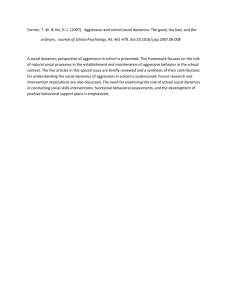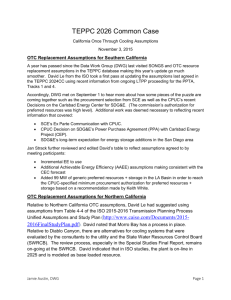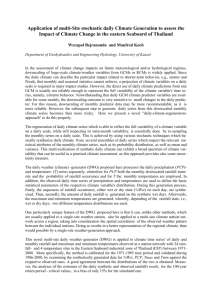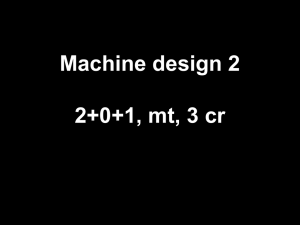DWG Procedure Manual Revision 9
advertisement
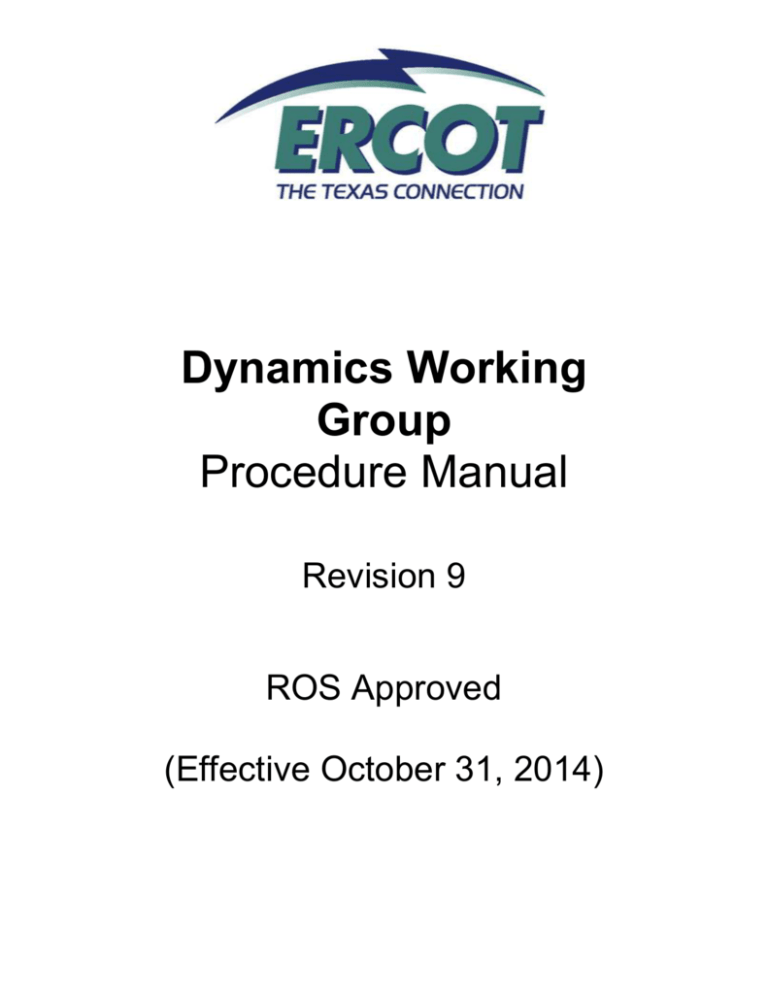
Dynamics Working Group Procedure Manual Revision 9 ROS Approved (Effective October 31, 2014) TABLE OF CONTENTS Foreword ............................................................................................................. 4 1 Activities of the DWG .................................................................................... 5 2 Administrative Procedures ........................................................................... 5 2.1 Membership............................................................................................. 5 2.2 Duties of Chair and Vice-Chair .............................................................. 5 2.3 Meetings .................................................................................................. 5 2.4 Reports to ROS ....................................................................................... 5 3 Dynamics Data ............................................................................................... 6 3.1 General .................................................................................................... 6 3.1.1 Software ........................................................................................................................... 6 3.1.2 Dynamics Models – General ............................................................................................ 6 3.1.3 Standard Dynamics Models ............................................................................................. 6 3.1.4 User-Written Dynamics Models ...................................................................................... 7 3.1.5 Maintenance of Dynamics Models .................................................................................. 7 3.1.6 Dynamics Data for Existing Equipment .......................................................................... 7 3.1.7 Dynamics Data for Planned Equipment ........................................................................... 8 3.2 Dynamics Data for Equipment Owned by Resource Entities (RE) ..... 8 3.2.1 Dynamics Data Requirements for New Equipment ......................................................... 8 3.2.2 Updates to Existing Dynamics Data ...............................................................................11 3.3 Data for Load Resource ....................................................................... 11 3.4 Dynamics Data for Equipment Owned by Transmission-Distribution Service Providers (TDSP) ........................................................................... 11 3.4.1 Under Frequency Firm Load Shedding Relay Data (UFLS) ...........................................11 3.4.2 Under Voltage Load Shedding Relay Data .....................................................................12 3.4.3 Protective Relay Data .....................................................................................................12 3.4.4 Load Model Data ............................................................................................................13 3.4.5 Other Types of Dynamics Data .......................................................................................13 3.4.6 Missing or Problematic Dynamics Data .........................................................................14 3.4.7 Dynamics Data and Stability Book Storage ....................................................................14 4 Overview of DWG Activities........................................................................ 15 4.1 Updating Dynamics Data and Flat Starts ............................................ 15 Dynamics Working Group Procedure Manual 2 4.1.1 Schedule for Dynamic Data Updates and Flat Start Cases .............................................15 4.1.2 Dynamics Data Updates ..................................................................................................15 4.1.3 Dynamics Data Screening ...............................................................................................16 4.1.4 Flat Start Criteria ............................................................................................................16 4.2 Post Flat Start Activities....................................................................... 16 4.2.1 Distribution of Flat Start Results and the Dynamics Data Base ......................................16 4.2.2 Stability Book .................................................................................................................16 4.2.3 DWG Coordination with the Steady State Working Group ............................................17 4.2.4 DWG Dynamic Contingency Assumptions List .............................................................17 4.3 Other DWG Activities............................................................................ 18 4.3.1 Dynamic Disturbance Recording (DDR) Equipment Annual Review ............................18 4.3.2 Location Requirements: ..................................................................................................18 4.3.3 Data Recording Requirements: .......................................................................................18 4.3.4 Triggering Requirements: ...............................................................................................19 1. Data Reporting Requirements: .................................................................................................19 4.3.5 Maintenance and Testing Requirements: ........................................................................19 4.3.6 Event Simulation.............................................................................................................19 4.3.7 Procedure Manual Revision Guidelines ..........................................................................20 4.4 DWG Study Methodologies and Criteria ............................................. 21 4.4.1 Transient Voltage Criteria...............................................................................................21 4.4.2 Damping Criteria ............................................................................................................21 4.4.3 Voltage Instability Identification in Stability Studies .....................................................21 4.4.4 Cascading Identification in Stability Studies ..................................................................21 4.4.5 Uncontrolled Islanding Identification in Stability Studies ..............................................21 4.4.6 Generator Protection Assumptions .................................................................................21 Dynamics Working Group Procedure Manual 3 Foreword This Procedure Manual is intended for use by the stakeholder members of the Electric Reliability Council of Texas (ERCOT) for the purpose of creating and maintaining the dynamics database and dynamics simulation cases which are used to evaluate the dynamic performance of the ERCOT system. The majority of ERCOT members utilize Siemens Power Technologies Inc. (PTI) Power System Simulator (PSS/E) software. Consequently, the various activities in the procedure manual incorporate PSS/E procedures and nomenclature in describing these activities. Wherever possible, a description of the PSS/E activity is given so users of software other than PSS/E may implement similar actions. Dynamics Working Group Procedure Manual 4 1 Activities of the DWG 1.1 DWG prepares the dynamic data set for the ERCOT system from data supplied by equipment owners and load serving entities. ERCOT coordinates the compilation and publication of dynamics data. The dynamics data will be published in the form of a dynamics study cases (flat start cases) as described within these procedures. 1.2 Prepare a Stability Book that documents data used in the flat start cases. 1.3 Perform other activities as directed by ROS. 2 Administrative Procedures 2.1 Membership DWG membership is open to ERCOT, Transmission Service Providers (TSPs), and Texas Reliability Entity (TRE). Each ERCOT area, as defined in the base case, shall have at least one designated Dynamics Working Group (DWG) member. Each designated DWG member shall be identified in the DWG members list, and the list will be updated as needed. Each January, the DWG will nominate a Chair and Vice-Chair to be approved by the Reliability and Operating Subcommittee (ROS). 2.2 Duties of Chair and Vice-Chair The Chair will coordinate the activities of the DWG and represent the DWG at the ROS Meetings and other working group meetings as required. The Vice-Chair will support the Chair and fulfill the duties of the Chair in the absence of the Chair. 2.3 Meetings The DWG will meet at least quarterly. The Chair may coordinate additional meetings as needed to facilities the activities of the DWG. Agendas and meeting schedules will be published at least two weeks prior to the meeting. The minutes of each meeting will be distributed to DWG members. 2.4 Reports to ROS Each month, the DWG will provide a written report to the ROS. Dynamics Working Group Procedure Manual 5 3 Dynamics Data 3.1 General 3.1.1 Software The current version of the planning software used by the DWG is PSSE version 33. During years where a PSS/E version change is being conducted, the previous PSS/E version user defined models shall also be provided until a full transition is completed. 2014 is a PSS/E version change year so PSS/E version 32 user defined models and data shall be provided until DWG completes the transition to PSS/E version 33. 3.1.2 Dynamics Models – General ERCOT staff shall inform the ERCOT compliance team if any dynamic data has not been made available or is missing. Dynamic models shall fulfil the following requirements: Each dynamic device requires models with model parameters resulting in a tuned complete model that represent the dynamics of the device. Dynamic models shall be compatible with the software listed in section 3.1.1. Models should not interfere with the operation of other models. All associated dynamic models for a given generating unit shall be provided with the same MBASE in accordance with the machine characteristics where the MBASE is typically the generator MVA rating. No model shall restrict the DWG from using any integration time-step less than or equal to a ¼ cycle in simulations.1 Models shall be submitted to both ERCOT and the connecting TSP 3.1.3 Standard Dynamics Models The use of PSS/E Standard dynamics models is preferred when they can accurately represent the dynamic performance of the device being modeled. 1 Siemens PSS/E standard library models allow time constants of less than 1 cycle (0.016667 seconds) but use an internal method so that a ¼ cycle (0.004167 seconds) integration time-step can be used for simulations. For example, Siemens PSS/E uses an internal integration for models that would normally require less than a ¼ cycle integration time-step. Dynamics Working Group Procedure Manual 6 3.1.4 User-Written Dynamics Models A user written model is any model that is not a standard Siemens PSS/E library model. When no compatible PSS/E standard dynamics model(s) can be used to represent the dynamics of a device, accurate and appropriate user written models can be used, if accepted by ERCOT and the DWG after being tested for compatibility with the flat start cases. User written models shall be submitted to both ERCOT and the connecting TSP. User-written models can include either dynamic model source code for the dynamic equipment and associated data or dynamic model object code for the dynamic equipment and associated data. User-written source code, object code, and parameters must be updated for PSS/E version changes per section 3.1.1 or as requested by the DWG and/or ERCOT. Models requiring allocation of bus numbers shall be compatible with the ERCOT bus numbering system, and shall allow the user to determine the allocation of the bus numbers When a user-written model(s) is submitted in place of a generic or library model, it must be accompanied by the following: Technical description of characteristics of the model, Block diagram for the model, Values and names for all model parameters, Text form of the model parameters (PSSE dyr file format), List of all state variables, A user’s guide for each model shall be provided and, Appropriate procedures and considerations for using the model in dynamic simulations 3.1.5 Maintenance of Dynamics Models Maintenance of the models is the responsibility of the device owner. Models shall be maintained in accordance with section 3.2. Any userwritten dynamics models shall also be maintained to fulfill the requirements in section 3.1.4. 3.1.6 Dynamics Data for Existing Equipment “As built” data is required for all completed facilities. Unit-specific data shall be reported for generator units installed after 1990. If a permanent new equipment or temporary equipment in place for more than a year is added to the facility then the dynamic model data needs to be reDynamics Working Group Procedure Manual 7 submitted. “As Built” data shall be submitted in accordance with section 3.2. Any “As Built” user-written dynamics models shall also be maintained to fulfill the requirements in section 3.1.4. 3.1.7 Dynamics Data for Planned Equipment The development of future year case data may require an entity to submit the best available information for the planned equipment prior to development of a detailed design. In such cases, estimated or typical manufacturer’s dynamics data, based on units of similar design and characteristics, may be submitted. However, the resource owner shall update the model information upon completion of the detailed design and again upon commissioning the equipment. Dynamics data for planned equipment shall be submitted in accordance with section 3.2. Any Userwritten dynamics models for planned equipment shall also be maintained to fulfill the requirements in section 3.1.4. 3.2 Dynamics Data for Equipment Owned by Resource Entities (RE) 3.2.1 Dynamics Data Requirements for New Equipment Note: This section addresses the requirements stated in R1 of NERC Standard MOD 032-1 (effective July 1, 2015). RE’s are responsible for providing models with model parameters resulting in a tuned model that represents the dynamic performance of the device. Final responsibility for the submission and the accuracy of the dynamic data lies on the RE’s. ERCOT and the DWG will provide voluntary assistance if requested by RE’s to complete parameter tuning and prepare PSS/E model records. ERCOT will serve as the single point of contact to facilitate these activities. If the DWG identifies inappropriate or incomplete dynamics data, the appropriate DWG member will act through ERCOT to resolve discrepancies with the data owner. The DWG member of the which the generator is connected is responsible for incorporating the dynamics data received from the RE into the DWG Flat Start cases during annual updates RE shall fulfill its interconnection data requirement by completing the corresponding sections of the RARF for their facilities with dynamic models data embedded or attached to their RARF submission. Dynamics Working Group Procedure Manual 8 The following two subsections describe data requirements for two distinct categories of generation facilities: 3.2.1.1 Conventional Generation Facilities Interconnecting More Than 10 MVA of Generation Capacity: a. The model data shall include, at minimum, a generator model, a governor model, an exciter model, a power system stabilizer model (if applicable) and excitation limiter models. b. Classical model data is not acceptable. c. Estimated or typical model data is not acceptable for units after they are already connected to the ERCOT system. d. In accordance with the SSWG procedure manual, all non self-serve generation connected to the transmission system at 60kV and above with at least 10 MW aggregated at the point of interconnect must be explicitly modeled. This translates to (1) no lumping of generating units and (2) explicit modeling of each step-up transformer. e. The SSWG manual states that station auxiliary load for generating plants should not be modeled explicitly at the generator bus. However, explicit modeling of station auxiliary load may be necessary for dynamic simulations. f. All combined cycle steam turbines shall use the CIGRE (International Council on Large Electric Systems) governor model, as developed by Siemens PTI and implemented by ERCOT. g. All combined cycle gas turbine models shall be compatible with the CIGRE steam turbine model. The RE is responsible for maintaining CIGRE steam turbine model parameters. 3.2.1.2 Intermittent Renewable Resources (e.g. Wind and Solar) Facilities: The RE shall provide the following data as applicable to the generator technology: a. Model, data and description of voltage control method. b. Model, data and description of how they will meet ERCOT reactive requirements. c. A one-line diagram of the proposed facility. Dynamics Working Group Procedure Manual 9 d. Data for all transformers. The data should include: MVA rating. High and low side rated voltage. Number of taps, and step size. Impedance, including base values if different from rated values listed above. e. Generator data including: Generator manufacturer and model. Rated voltage. Rated MVA. Reactive capability, leading and lagging. Rated MW output. Net MW output. Transient or subtransient reactance, including base values. Transient or subtransient time constant. Total inertia constant, H, of generator, including the shaft and gearbox. Under frequency and under voltage protection settings. Over frequency and over voltage protection settings. Number of machines by manufacturer types f. List any reactive sources such as capacitor banks, STATCOMS, etc. Provide the number of devices, location of the devices, step size, speed of switching, location where voltage is sensed and controlled, control strategy, and voltage limits. For dynamic reactive devices, provide the appropriate model and data. g. Line data from the point of connection to each generator. Include: Line type (overhead or underground) Line length Line resistance in ohms/1000 ft Line reactance in ohms/1000 ft Line susceptance in mhos/1000 ft Dynamics Working Group Procedure Manual 10 h. Wind turbine models shall account for rotor mass, aerodynamic energy conversion, pitch control. 3.2.2 Updates to Existing Dynamics Data The requirements of section 3.2.1 apply to all updated models and data. Any change in generator dynamics data, associated generator data, or wind farm items listed in section 3.2.1 , or other types of equipment listed in this procedure, determined either through field testing or after changing relevant equipment or equipment settings shall be reported to ERCOT and the TSP to which they are connected, by the RE within 30 days. Model data shall be provided in the same form (such as PSS/E model data sheets) as required in section 3.2.1. Model parameter tuning updates may also be required to perform dynamic studies. Obsolete data should be deleted As per section 3.1.4., when updated equipment modifications are provided, data for all other related models shall be updated with the same MBASE. For example, replacement of an old excitation system with a new excitation system would require an RE to provide updated model data. 3.3 Data for Load Resource Load Resource models used for system frequency response shall be prepared using a PSSE standard model. Data for the Load Resource model shall be documented in the Stability Book and .dyr files posted to the DWG data site. 3.4 Dynamics Data for Equipment Owned by Transmission-Distribution Service Providers (TDSP) 3.4.1 Under Frequency Firm Load Shedding Relay Data (UFLS) UFLS data shall be prepared annually in accordance with ERCOT and NERC standards. TDSPs are responsible for preparing the UFLS relay model records for their respective loads . The TDSP shall submit the UFLS relay data to ERCOT in the form of a PSS/E dyre file using an appropriate model. The models should contain the necessary information to properly represent the UFLS relay actions in a dynamic study, including: a. Owner and operator of the UFLS program. b. Size and location of customer load, or percent of connected load, to be interrupted. c. Corresponding frequency set points. d. Overall scheme clearing times (includes all time delays, breaker clearing times, etc.). Dynamics Working Group Procedure Manual 11 Also, the TDSP should indicate any other schemes that are part of or impact the UFLS programs such as related generation protection, islanding schemes, automatic load restoration schemes, UVLS and Special Protection Systems. All UFLS data will be documented in the annual Stability Book. 3.4.2 Under Voltage Load Shedding Relay Data Note: This section addresses requirements stated in NERC Standards PRC-20 and PRC-21. Annually or after installation of any under voltage load shedding (UVLS) relays, the TDSP installing the UVLS relays will submit the corresponding relay model to ERCOT during the annual data update or as needed for DWG studies. The DWG member shall submit the UVLS relay data in the form of a PSSE dyre file using an appropriate model. The model shall contain the necessary information to properly represent the under voltage relay actions in a dynamic study, including: a. Owner and operator of the UVLS program. b. Size and location of customer load, or percent of connected load, to be interrupted. c. Corresponding voltage set points. d. Overall scheme clearing times (includes all time delays, breaker clearing times, etc.). Also, the TDSP should indicate any other schemes that are part of or impact the UVLS programs such as related generation protection, islanding schemes, automatic load restoration schemes, UFLS and Special Protection Systems. All UVLS data will be documented in the annual Stability Book. 3.4.3 Protective Relay Data The operation of protection, control, and special protection systems can affect the dynamic performance of the ERCOT system during and following contingencies. Planning, documenting, maintaining, or other activities associated with these systems is outside the scope of the DWG. However, because they can affect dynamic performance, the DWG should, on an as needed basis, identify and document protection, control, and special protection systems, which affect multiple transmission providers. Identification activities will normally require the assistance of individuals or groups outside the DWG. The specific information to be considered for inclusion will depend on the type, purpose, and scope of study. Dynamics Working Group Procedure Manual 12 Protection, control, and special protection systems included in the DWG database should be in the form of a dynamic model and shall be compatible with the software listed in section 3.1.1. . Protection, control, and special protection systems adequately modeled for dynamic purposes by other working groups only need to be referenced in the DWG study reports. The DWG member, as part of the annual database update, shall review and update as necessary protection, control, and special protection systems already in the DWG database. This review should include evaluating the existing data for applicability and accuracy. Protective relay data included in a DWG flat start case shall be documented in the Stability Book. 3.4.4 Load Model Data Note: This section addresses the requirements stated in R1 of NERC Standard MOD 032-1 and R2.4.1 of NERC Standard TPL-001-4. Another key component of any dynamic study is the load model and its representation as a function of changing frequency or voltage. The load model can have a significant effect on results of dynamic analysis. For this reason, it is important to consider the load model and to use an appropriate model during the study. The annual Stability Book will include standard load models for each area, composed of a mix of constant impedance (Z), constant current (I), and constant power (P) representations, known as ZIP models. PSS/E CONL activity is used to incorporate the ZIP models into a PSS/E study. Additional load detail (large motor MW, small motor MW, etc.) is provided in the Annual Load Data Request (ALDR). ALDR information can be used with generic motor model parameters for screening purposes. Within 30 days of a written request from ERCOT, a TDSP will provide input on induction motor parameter assumptions and/or a load motor model dyr file to be in an ERCOT study. A standard load-frequency dependency model (LDFRAL) will also be documented in the Stability Book. Each study performed by the DWG, ERCOT, or by TDSP members submitted to an ERCOT regional planning group should document the load modeling assumptions in the body of the report. 3.4.5 Other Types of Dynamics Data Note: This section addresses requirements stated in R1 of NERC Standard MOD 032-1 (effective July 1, 2015). Dynamics Working Group Procedure Manual 13 After a dynamic element planned to be installed on the transmission system owned by a TDSP is modeled in the SSWG base cases such as an SVC, STATCOM, Superconducting Magnetic Energy Storage (SMES), DC ties, and Variable-Frequency Transformer data, the DWG member of the TDSP owning the equipment will provide the corresponding PSS/E model to the designated DWG member during the annual dynamic database update or as needed for DWG studies. 3.4.6 Missing or Problematic Dynamics Data The DWG is responsible for reviewing the dynamics data on an annual basis or as requested by ROS and reporting to the ROS any missing data or unresolved issues relating to data submission requirements. DWG will report select data problems to the respective ERCOT working group per Section 4.2.3. If there are problems with the data, the DWG will work through ERCOT with the equipment owner to resolve data problems. However, the final responsibility for the submission and the accuracy of the data lies with the equipment owner. All of the data and the revisions requested by ERCOT shall be resolved by the entity owning the equipment within 30 days. Until valid data becomes available, ERCOT or the DWG member to whose system the equipment is connected shall recommend an interim solution to the missing or problematic data. 3.4.7 Dynamics Data and Stability Book Storage ERCOT shall make available to the DWG members in electronic format the dynamics data described in this procedure. ERCOT shall maintain a repository of dynamics data approved by the DWG and will maintain the submitted revisions. ERCOT staff shall inform the ERCOT compliance team if any data is missing or has not been made available. Dynamics Working Group Procedure Manual 14 4 Overview of DWG Activities 4.1 Updating Dynamics Data and Flat Starts 4.1.1 Schedule for Dynamic Data Updates and Flat Start Cases Note: This section addresses requirements stated in R2 of NERC Standards TPL-001-4. Each February, the DWG shall prepare a schedule for updating dynamics data and preparing the DWG flat start cases. The schedule shall be constructed to align with the Steady State Working Group (SSWG) schedule so that a seed case for a flat start can be selected following a finish date of an update. Typical Schedule: Long term case completed before summer and typically finished in March Near term case completed before summer and typically finished in June HWLL term case completed concurrently with the near term case and typically finished in September. he DWG shall prepare the following flat start cases based on the following SSWG steady state cases: Near Term On-Peak: Second year (Y+2) summer on-peak case of the latest Dataset B cases Near Term Off-Peak Case: The high wind low load case (Y+3) off-peak case from the latest Dataset B cases Long Term On-Peak Case: Last year (Y+6) of summer on-peak case of the latest Dataset B cases The DWG may choose to flat start additional cases. After January 1st, 2015, ERCOT shall prepare all the flat start cases. 4.1.2 Dynamics Data Updates Each DWG member shall review the dynamic data from the prior year for its portion of the ERCOT System and provide necessary updates according to the schedule established in section 4.1.1. The changes in the data must be identified and submitted with the updated data. Data for mothballed units shall be retained. Obsolete data should be deleted. Dynamics Working Group Procedure Manual 15 Other revisions of data that should be submitted to the designated DWG member include updates to the load model, Zsource corrections, generation netting, or any other modifications to the network necessary for dynamic studies. 4.1.3 Dynamics Data Screening DWG members should review the dynamics data for equipment connected to their system for completeness and applicability. The data should be appropriate for the model, and the model should be appropriate for the equipment. Before submitting data for inclusion in updated dynamics base cases, each DWG member should perform dynamics data screening. 4.1.4 Flat Start Criteria DWG Flat Start cases shall: Initialize with no errors; Demonstrate that simulation output channels for frequency, voltage and power do not deviate from an acceptable range for a ten-second run with no disturbance. The product of a successful flat start will be a PSS/E simulationready base case (the unconverted base case) with its associated dynamic data files including user models (.dyr, .obj, .lib, and .dll files), stability data change documentation, python (.py) files and response files (.idv) files. The product of a successful flat start also includes the steps taken to build the flat start case such as network model changes (i.e. changing the schedule of the North DC, tuning voltages, etc.). 4.2 Post Flat Start Activities 4.2.1 Distribution of Flat Start Results and the Dynamics Data Base Upon completion of each flat start, an electronic copy of all dynamics data and final data files will be distributed electronically in PSS/E format to each of the DWG members and to ERCOT System Planning for archiving. This dynamic data distribution shall be within the schedule established by the DWG for the given flat start. 4.2.2 Stability Book The Stability Book is an annual document used to record dynamics data changes and/or corrections required during the flat start processes. Recommendations to revise load flow data are also included in the book. DWG Members are required to communicate these recommendations to Dynamics Working Group Procedure Manual 16 other respective working groups, including Steady State Working Group, Operations Working Group, and Network Data Support Working Group, to eliminate recurring problems. The following information is included in Stability Book: Deviation tables or plots of the flat start results are included to verify the successful completion of the flat start process. Dynamics data. This data is in the DOCU ALL PSS/E activity format. Load shedding relay data submitted by each of the appropriate DWG members. Additional information identified for inclusion by Section 3.4 4.2.3 DWG Coordination with the Steady State Working Group To support coordination with the Steady State Working Group, Operations Working Group, and Network Data Support Working Group a list of the changes to the items listed below will be provided to the ERCOT Steady State Working Group Representative member to assure conflicting data is addressed. ERCOT shall compile the list following finalization of the flat start. For Flat Starts, data changes for one of categories list below submitted by shall be grouped and labeled by the submitter to support efficient compilation of these changes at the end of the flat start by ERCOT. The following items should be provided to these working groups for data coordination: Unit MVA Base. This is also known as MBase used by the dynamic model. Zsource changes. Reactive machine impedances required for dynamic initialization of models. 4.2.4 DWG Dynamic Contingency Assumptions List The DWG shall construct a dynamic contingency assumptions list detailing contingency assumptions for each TSP for the purpose of screening studies conducted by ERCOT and the DWG members. ERCOT and the DWG members shall annually review and update the dynamic contingency assumption list. Upon completion of the annual review, ERCOT shall collect the contingency assumptions and submit the finalized dynamic contingency assumptions list to the DWG. The assumptions would include: Dynamics Working Group Procedure Manual 17 Breaker trip time for normal clearing, Breaker trip time for delayed clearing due to stuck breaker Breaker trip time for delayed clearing due to relay failure Relay characteristic assumptions to assess generic apparent impedance swings that can trip any transmission system elements Other assumptions deemed necessary by DWG as specified during the annual review 4.3 Other DWG Activities 4.3.1 Dynamic Disturbance Recording (DDR) Equipment Annual Review Note: This section addresses NERC Blackout Recommendation 12b. The purpose for installing dynamic disturbance recording (DDR) equipment is to: Collect actual data following a dynamic disturbance. Enable the results of dynamic simulations to be evaluated for effectiveness. 4.3.2 Location Requirements: ERCOT and the DWG shall prepare a list and perform an annual review of facilities that operate above 100 kV, are part of a dynamic stability (not transient stability) interface, and require the installation of a DDR. ERCOT and the DWG shall forward any revised DDR facility list to the Reliability and Operating Subcommittee (ROS) for its review and approval. Upon approval of the DDR facility list, facility owners shall have six months to install and place in service DDRs at each listed facility. DDRs shall be removed or taken out of service by the same process. 4.3.3 Data Recording Requirements: The appropriate quantities, such as the following, must be recorded for equipment operating at 100 kV or above at facilities where DDR equipment is required: Bus Voltage Line Current MW and MVAR flow Frequency Dynamics Working Group Procedure Manual 18 4.3.4 Triggering Requirements: DDR equipment triggering should occur for one or more of system voltage magnitude, current magnitude, or frequency magnitude disturbances (V, I, or f) without requiring any circuit breaker operations or trip outputs from protective relay systems. Disturbance recording equipment shall be capable of continuous recording for not less than 5 minutes and shall be retrievable for a period of not less than 72 hours. Dynamic Disturbance Recorders (DDR’s) should be time synchronized when practical. The sampling rate for DDR’s should be 240 samples per second. 1. Data Reporting Requirements: At DDR installations where communication equipment exists and it is practical, communication from the device should be automatic to an ERCOT central database. Where communication equipment does not exist or automatic communication from the device to ERCOT is not practical, facility owners who have installed DDR's may report data for any event they consider significant to ERCOT. ERCOT may request facility owners who have installed DDR's to report data for any event. ERCOT’s request should be made within 24 hours after the event to allow the transmission provider adequate time to retrieve the data. DDR data of significant events shall be reported to ERCOT at least annually for compilation into a database. The database compiled by ERCOT shall be made available to all ERCOT members for verifying and improving system models, or analyzing system disturbances. Submitted data will be retained by ERCOT for a minimum of one year. DDR records shall be provided to ERCOT and NERC upon request. Disturbance records shall be retained and made available for at least one year from the date the record was made. DDR records shall be shared between entities, upon request, for the analysis of system disturbances. 4.3.5 Maintenance and Testing Requirements: DDR equipment must be properly maintained and tested in accordance with the manufacturer’s recommendations. Maintenance and test records shall be provided to ERCOT upon request within 30 business days. 4.3.6 Event Simulation Note: This section addresses NERC blackout recommendation 14. Dynamics Working Group Procedure Manual 19 When requested by ROS, the DWG will simulate an actual disturbance event for the purpose of assessing the fidelity of the ERCOT dynamics models and data against actual system performance recordings of the event. In addition, the DWG will annually consider recent significant events to determine their suitability for an event simulation. The DWG will consider their work load and the type of information likely to be obtained in making a decision as to whether to simulate an event. 4.3.7 Procedure Manual Revision Guidelines Note: This section addresses requirements stated in NERC Standards MOD-013-0 (R2). The DWG is responsible for maintaining and updating this Procedure Manual. Revisions, additions and/or deletions to this Procedure Manual may be undertaken at such times that the DWG feels it is necessary due to changes in PSS/E dynamic simulation software or to meet new and/or revised requirements of NERC, ERCOT, or any other organization having oversight or regulatory authority. At least annually, the DWG Chair shall request a thorough review of the current Procedure Manual for any needed revisions. The notification will request that proposed revisions be submitted to the DWG Chair (or the Chair’s designate) for consolidation and distribution to all DWG members for comment and/or additional revision. The DWG Chair should give consideration to being able procedure complete the review and revision process in time to avoid any delays in collecting dynamic data or completing other DWG work. The DWG Chair may seek approval of any revision, addition, or deletion to the Procedure Manual by email vote, regular meeting, or called special meeting as deemed necessary or requested by DWG membership. Dynamics Working Group Procedure Manual 20 4.4 DWG Study Methodologies and Criteria Note: This section addresses requirements stated in R4, R5 and R6 of NERC Standards TPL-001-4 (effective January 1, 2016). The gray boxed sections of the DWG Procedure Manual provide interim DWG guidelines for the new TPL-001-4 until final language is approved for the Planning Guide via a PGRR. 4.4.1 Transient Voltage Criteria Transient Voltage Criteria applies to transmission level buses above 100 kV. For NERC planning event P1, voltage shall recover to 0.90 p.u. within five seconds after clearing the fault. For NERC planning events P2-P7, voltage shall recover to 0.90 p.u. within ten seconds after clearing the fault. 4.4.2 Damping Criteria For NERC planning event P1-P7, power oscillation within the range of 0.2 Hz to 2 Hz shall decay with a minimum of 3% damping ratio. 4.4.3 Voltage Instability Identification in Stability Studies Voltage Instability is indicated by severely low bus voltage or bus voltage collapse. Voltage Instability could cause: Significant amount of customer initiated motor tripping is activated due to motor stalling. Loss of generator(s) due to low voltage Voltage collapse of an area ERCOT Planning Guide Section 4.1.1.3: Voltage Stability Margin identifies the voltage stability requirements for maintaining posttransient voltage stability. Dynamics Working Group Procedure Manual 21 4.4.4 Cascading Identification in Stability Studies Cascading Outage Definition - Cascading Outages are defined as the uncontrolled loss of any system facilities or load, whether because of thermal overload, voltage collapse, or loss of synchronism, except those occurring as a result of fault isolation. Cascading is indicated by one or more of the following conditions: Uncontrolled sequential loss of generators Uncontrolled sequential loss of load Uncontrolled sequential loss of branches. Cascading could cause conditions like: Voltage collapse of an area Expanding number of buses with voltage instability System islanding, frequency instability due to power-load unbalance 4.4.5 Uncontrolled Islanding Identification in Stability Studies Uncontrolled islanding is the separation and loss of synchronism between a portion of the interconnection and the remaining interconnected system. Generators disconnected from the System by fault clearing action or by a Special Protection System are not considered out of synchronism. Similarly, islands formed from being disconnected from the System by fault clearing action or by a Special Protection System are not considered an uncontrolled island. Uncontrolled islanding is indicated by the formation of subnetwork islands after the uncontrolled loss of branches. Subnetworks islands have the following characteristics: The subnetwork islands have both generation and load to support the continuation of the island. The subnetworks formed are not connected to each other. Uncontrolled islanding in a screening study could cause: Out of step generators A frequency disturbance Eventual collapse of one of the islands due to frequency or voltage instabilities caused by the generation-load unbalance in the subnetwork island. Dynamics Working Group Procedure Manual 22 4.4.6 Generator Protection Assumptions Note: This section addresses requirements stated in R4.3.1.2 of NERC Standards TPL-001-4 (effective January 1, 2016). If dynamic models are not provided for Generator protection schemes, generic generator protection shall be assumed for screening purposes 1. For synchronous generators, rotor angle above 180 degrees would cause a generator to trip. 2. Generators will be assumed to be compliant with the minimum requirements of Section 2.9 Voltage Ride-Through Requirements for Generation Resources of the ERCOT Nodal Operating Guide. 3. Generators will be assumed to be compliant with the minimum requirements of Section 2.6 Requirements for Under-Frequency Relaying of the ERCOT Nodal Operating Guide. Dynamics Working Group Procedure Manual 23

